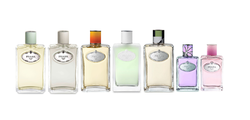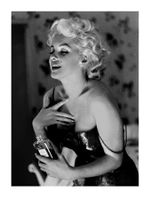Perfume
Perfumes are fragrant liquids typically made from essential oils extracted from flowers and spices, used to impart a pleasant smell to one's body or clothes. It is not only used for women to improve their smell, but also used for objects such as furniture or air freshener. People generally know that perfume is made of essential oil with alcohol, but making a perfume is not as simple as written. Perfumes are compound and every scent of them is not a single chemical compounds.
History of perfume
Perfume used a lot these days, especially by women. They use this to make them more attractive by fragrance, or to obscure odor. Perfume is a liquid cosmetic which includes alcohol and essential oil (essence). Essential oil is generally gotten from leaves and flowers, such as rose, lilac, lemon, rosemary, lavender, peony, musk, or joy perfume tree, which is well known for the raw material of Chanel No.5.[1] Perfume industry makes over $10 billion these days. However, the history of perfume is as long as human history. It has been approximately more or less than thousand years. Early Egyptians traditionally used perfumed balms for special occasions. They made perfume as a unguent and then rubbed into the skin, just same as people these days doing aromatherapy with perfumed oils. [2] Egyptians were the first nation who used perfume for personal enjoyment. But since the ingredients for perfume were expensive, perfume was only used by priests, queens, and emperors. They originally used perfume after their death to reduce stink from their dead bodies. Perfume then spread to Greece, Romans, Arabia...etc. [3] By the 1600s, people started to apply scents not only to themselves, but also to objects such as furniture, gloves, and fans. The late 19th century was the period when perfume that we usually know (Synthetic perfumes) first used. Since some ingredients for perfume are hard to get, or expensive, people started to make new scents chemically. [2]
Perfume chemistry
Basically, perfume is made of essential oil and alcohol. However making perfume is not that simple as it written. Most of the perfumes are made with three essential oils, top notes, middle notes, and base notes. The word 'note' is just perfume jargon for an individual smell. Top notes are the scents that fades most quickly so that easily give people the first impression. Middle notes lasts little longer than top notes and provide the dominant scent of perfume. Usually, rose, juniper or marjoram are used for the middle notes. Base notes are the one which lasts longest, and people usually recognize this as reverberation of the scent. Anise, myrrh and frankincense are commonly used for the base notes. These days, perfumes are made artificially in the factory. Since we know the chemical nature of these essential oils, perfumes can be made chemically. By mixing up different oils, we can make artificial scents that are similar to the natural ones. For example, a mixture of geraniol, citronellol, phenylethyl alcohol and linalool in a ratio of 30:25:25:5 will make the scent just same as roses.[1]
Chemical reactions can also be proceeded by perfume itself. Let's think about the perfume on your shelf. The lamp or sunlight in your room are able to bust and weaken the bonds of those fragrance molecules. Air can also corrode the fragrance by oxidation. Therefore, best way to archive perfume is to store it at room temperature, in the dark and in spray bottle. Then the scent of perfume will preserved at least two years. However, even though the scent of certain perfume smells awesome, if it does not fit on the user, it would be worthless. User's body temperature oiliness is most important. The top notes will evaporate faster from warm and dry skin than cool and oily skin. Otherwise, by the time pass and the middle notes start to emerge, the perfume smells the same on everyone. [4]
Compounds of aroma
Perfumes are aromatic compounds often blended together into mixtures. Flowers, the material which is used mostly for the scent of perfume, give off a complex mix of volatile organic chemicals, but not all of these contributes to the aroma. We can’t point to single compounds how the flowers' scents cause, but we can identify scents that have a major impact on the aroma which our noses can detect. The following would be examples of this. First of all, scent of rose is majorly influenced by (-)-cis-rose oxide. This molecule is a particular isomer of rose oxide. and the one which contributes the typical floral rose fragrance. It’s detectable by our noses at very low concentrations in air – down as low as 5 parts per billion. Another compound which contributes to the fragrant of roses is beta-damascenone. It has an lower odor threshold than rose oxide has. Additionally, Lilacs are also used for the fragrance broadly. Major component of the fragrance is (E)-beta-ocimene. Lilac aldehyde and lilac alcohol are also isolates used for perfumes. Both rose and lilac aroma compounds have different number of isomers with various impacts on the overall scent of the flowers. Benzyl methyl ether also impacts significantly on their scent. [5]
Video
Some chemicals can appear in perfume include synthetic scents, preservatives and other man-made ingredients.
References
- ↑ 1.0 1.1 .what makes perfume smell nice humantouchofchemistry. Web. last accessed on 20, April, 2015. Author unknown.
- ↑ 2.0 2.1 Thomas, Pauline. Perfume fashion history fashion-era. Web. last accessed on 5, May, 2015.
- ↑ The History of Perfume everythinkaboutperfume. Web. last accessed on 5, May, 2015 Author unknown.
- ↑ Nasr, SusanHow Perfume Works howstuffworks. Web. last accessed on 20, April, 2015.
- ↑ .The Chemical Compounds Behind the Smell of Flowers compoundchem. Web. uploaded on 12, February, 2015. author unknown.
| ||||||||||||||


